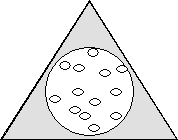4.4 The Molecular Dynamics Simulator
Chemical Concept Demonstrated: The kinetic
molecular theory
Demonstration:
- Watch the molecular dynamics simulator and the metal spheres inside. Increasing the
voltage is like increasing the temperature in a container.
- Study what happens to the frequency of colllisions with the wall as the
"temperature" increases and when more spheres are added.
|
 |
Observations:
As the "temperature" increases, the spheres hit the edges
more frequently. When more spheres are added, the interparticle collisions are more
frequent. The larger particles that are added move more slowly than their smaller
counterparts.
Explanations:
The kinetic molecular theory is demonstrated by use of the
simulator. The following aspects of the theory can be noted:
- Gas particles are small compared to the distance between them.
- Gas particle collisions are elastic.
- Gas particles are in a state of constant, random motion.
- The particles all move at different random speeds.
- The average kinetic energy of any given particle increases with the
temperature.
- The number of collisions increases with the addition of heat or more
particles.
- The length of time a particle can go without colliding with something
decreases with the addition of heat or more particles.
- The collisions between particles and the edge of the simulator
represent pressure. The pressure increases with the addition of heat or more
particles.
- The larger particles move more slowly because, although they are
imparted with the same average kinetic energy as the rest of the particles, they are also
more massive and need more of this energy to move the same average velocity of the smaller
particles.
- There is an inverse square relationship between the mass of the
particles and their average velocity.
